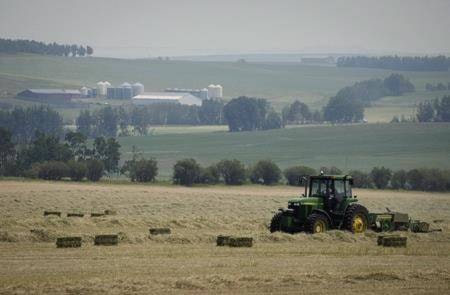Stettler-area farmer Larry Clarke wanted a water trough recently and headed to his local UFA.
The store had none and staff came up empty when they contacted other branches to see if they had any troughs.
“They don’t have any water troughs at any of their stores because so many of the farmers and ranchers have run out of water. Their dugouts and dams are dry.”
South of Stettler where it is hilly, many producers have typically used the natural sloughs to water their cattle.
“I’ve talked to those people and they’re running out of water in them too.”
Clarke is fortunate to have deep dugouts that were created when a highway was put through the area in the 1950s.
“I’ve got good dugouts but they are lower than I’ve seen them for some time.”
It is routine to get only one cut of hay in Stettler County, where it is typically drier than other parts of central Alberta. The results have been disappointing.
“I talked to one fella and he had 193 bales off a field last year and he had 91 bales this year. It was just under half of what the hay was last year.”
Pine Lake-area beef producer Kelly Fraser-Smith said it hasn’t been this dry on her land for nearly two decades.
To keep cattle watered, ranchers are having to pump out their sloughs because they are so low that cattle can’t drink from them without getting into the muck.
“I’ve seen lots of pastures being supplemented where people have water tanks out on trailers and watering the cows into a trough that way and hauling water out to the pastures.
“This is really early for us to do this. For me, the last time I remember it being like this was 2002,” said Fraser-Smith, who raises 125 purebreed cattle.
The farmer who got 91 bales might be counting himself lucky. “Honestly, that’s pretty good from what I hear to be getting half. I’m hearing of people getting a third of what they normally expect.”
Smith-Fraser hasn’t been baling yet so she doesn’t know what she will get, but it looks thin, she said.
She is keeping a close eye on her water supply, which was not replenished as much as usual because of the dry winter. Red Deer had the driest winter in 99 years, according to Environment Canada.
“I know in our operation there was such little runoff it didn’t fill our water holes. Especially in some of our pastures where we were relying on our sloughs there was no added, or very little added, moisture added to those sloughs to bring the water levels up.
“That lack of runoff, we’re really seeing the effects of it this summer with our water levels.”
And there is so little moisture, a second hay crop is doubtful at best for most farmers in the region.
Richard Lorenz, who raises cattle in the Markerville area, said his area has fared better than many.
“I think we’re holding our own. We definitely could use some moisture to help the crops finish filling and the pastures could always use use the rain.”
The picture gets gloomier the further east you go in Red Deer County, he said.
“I have heard of stories of pastures where they haven’t turned cows in.
“The pasture is brown, dried up.”
Lorenz is doubtful anyone will be seeing bumper crops.
“Will they be average? I guess time will tell. Hay crops are poor for sure,” he said, adding new crops and fertilized crops are doing better.
